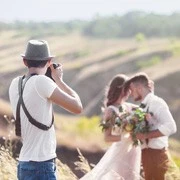Wedding Photography Tips and Techniques

As a wedding photographer, you are tasked with capturing the most important moments from the most important day in the lives of your clients. A wedding is more than another photoshoot, and your photographs will be displayed on walls, perused in albums, and shared with family for decades to come. That's why it is so important that you invest equal measures of time money into the techniques and equipment you use to capture those memories.
With most photographers moving to digital equipment in the last decade, technique has changed substantially. With the right approach, you can ensure your photographs are the perfect representation of that special day for years to come. Everything from camera resolution to technique is important to ensure high quality and results for wedding photographs. To help get the most out of those photos, here are some specific tips for taking exceptional wedding photographs.
Wedding Photography Tips and Techniques
The technical elements of photography are incredibly important on a wedding day. You may not have control over factors such as weather, lighting, or movement, so in the course of taking 1,000 or more photos, you need to be flexible and use techniques designed specifically for weddings. And above all else, your approach must be focused first and foremost on the couple and their wishes.
Juggling all of these priorities can be difficult, especially if this is one of the first weddings you have shot. Here are some important steps you should take before the special day to ensure you're ready -
Know Your Equipment Inside and Out
Before you shoot your first wedding (and before each shoot you go on), spread out your equipment and evaluate everything in advance. Take stock of your lenses, check your camera and ensure you know every mode and every setting inside and out. Know the limits of each setting, and be prepared to answer any questions the bride and groom have. If they ask for a certain type of shot and you don't know if your camera can do it, it can be embarrassing.
Have sufficient memory cards on hand, and test every piece of equipment before each shoot you go on. More importantly, practice as much as possible. Grab a friend and take a full run of shots to ensure your equipment is calibrated and ready for the big day. You can even stage a fake wedding to test your shots in advance of the day.
Plan Your Shots in Advance
Prepare a list of shots that the couple wants to include in their album. Speak with them in great detail about the family members, friends, and participants in the wedding that need to be in these prepared shots. By having a list of prepared shots in advance, you can set aside time the morning of the wedding, or shortly after the ceremony. Some shots to ensure you include on your list include -
- Groom Coverage - Get shots of the flower, tie, rings, cologne, cufflinks, and anything else the groom requests. Include photos of the groomsmen getting ready, all of them together, and any other goofy shots they want to get together (sunglasses and smiles, jackets over the shoulder, or roughhousing).
- Bride Coverage - The bride shots will often depend on what she wants included. Some examples include the back of the dress, looking at flowers, looking into the distance, smiling into the camera, and standing with the maid of honor.
- Bride and Groom Together - If the bride and groom will see each other before the ceremony, these are good shots to take in the morning. If not, you'll have to squeeze them in between ceremony and reception. The basics include a kiss, a hug, nose-to-nose, looking at each other, and all the goofy shots they'll want to share in ten or twenty years.
Communicate with the Couple How You Work
Every photographer is different, and your style is an important factor. Do you prefer natural lighting, staged photographs, interior or external shots, etc. These are the factors you should communicate with the couple so they can decide what shots they would like taken, and to make sure you're a right fit for them. Be sure to familiarize yourself with the space too. Whether in a church, on a beach, or in a park, visit the space in advance so you can plan the day out as much as possible.
Use of Flash in Wedding Photos
Because the majority of the photographs you'll take are active shots of an event in progress, lighting can't always be controlled. Flash use and lighting options are an important factor to consider in advance, especially if the space is outside. Some specific tips include -
- Try to get as many photos as possible with accessible light and no flash.
- When using flash, use a fill-flash technique to avoid poor composition.
- Use flash diffusers and reflectors to prevent photographs from being ruined by flash blowout.
- Use the main and primary lenses for all photos whenever possible.
At the same time, don't get lost in the technical details. Be ready for unexpected events, surprises, and the unique quirks and memories that will make the wedding a one-of-a-kind event for everyone attending.
Choosing the Right Partner for Wedding Photo Editing
A wedding is the single most important day in many people's lives and photographs are a vital part of that memory. Capturing and recording so many features of a wedding, they are a perfect expression of your art and the lives of the people you are capturing. A photographer can take natural and beautiful wedding photographs if they use the techniques in this article, and to ensure they are well processed, you should work with a partner who has years of experience doing so, such as Outsource2india.
Contact us right away for all your wedding photography post processing needs!
Get a FREE QUOTE!
Decide in 24 hours whether outsourcing will work for you.
Have specific requirements? Email us at: ![]()












